Effect of Strain Rate on Compressive Properties of Aluminium-Graphene Composites
Abstract
:1. Introduction
2. Material and Methods
3. Results and Discussion
4. Conclusions
Author Contributions
Funding
Data Availability Statement
Acknowledgments
Conflicts of Interest
References
- Chak, V.; Chattopadhyay, H.; Dora, T.L. A review on fabrication methods, reinforcements and mechanical properties of aluminum matrix composites. J. Manuf. Process. 2020, 56, 1059–1074. [Google Scholar] [CrossRef]
- Güler, Ö.; Bağcı, N. A short review on mechanical properties of graphene reinforced metal matrix composites. J. Mater. Res. Technol. 2020, 9, 6808–6833. [Google Scholar] [CrossRef]
- Khanna, V.; Kumar, V.; Bansal, S.A. Mechanical properties of aluminium-graphene/carbon nanotubes (CNTs) metal matrix composites: Advancement, opportunities and perspective. Mater. Res. Bull. 2021, 138, 111224. [Google Scholar] [CrossRef]
- Su, J.L.; Teng, J. Recent progress in graphene-reinforced aluminum matrix composites. Front. Mater. Sci. 2021, 15, 79–97. [Google Scholar] [CrossRef]
- Saboori, A.; Dadkhah, M.; Fino, P.; Pavese, M. An Overview of Metal Matrix Nanocomposites Reinforced with Graphene Nanoplatelets; Mechanical, Electrical and Thermophysical Properties. Metals 2018, 8, 423. [Google Scholar] [CrossRef] [Green Version]
- Zhang, P.X.; Yan, H.; Wei, L.; Zou, X.L.; Tang, B.B. Effect of T6 Heat Treatment on Microstructure and Hardness of Nanosized Al2O3 Reinforced 7075 Aluminum Matrix Composites. Metals 2019, 9, 44. [Google Scholar] [CrossRef] [Green Version]
- Al-Salihi, H.A.; Mahmood, A.A.; Alalkawi, H.J. Mechanical and wear behavior of AA7075 aluminum matrix composites reinforced by Al2O3 nanoparticles. Nanocomposites 2019, 5, 67–73. [Google Scholar] [CrossRef] [Green Version]
- Orłowska, M.; Pixner, F.; Hütter, A.; Enzinger, N.; Olejnik, L.; Lewandowska, M. Manufacturing of coarse and ul-trafine-grained aluminum matrix composites reinforced with Al2O3 nanoparticles via friction stir processing. J. Manuf. Process. 2022, 80, 359–373. [Google Scholar] [CrossRef]
- Ye, T.K.; Xu, Y.X.; Ren, J. Effects of SiC particle size on mechanical properties of SiC particle reinforced alumi-num metal matrix composite. Mater. Sci. Eng. A 2019, 753, 146–155. [Google Scholar] [CrossRef]
- Sadhu, K.K.; Mandal, N.; Sahoo, R.R. SiC/graphene reinforced aluminum metal matrix composites prepared by powder metallurgy: A review. J. Manuf. Process. 2023, 91, 10–43. [Google Scholar] [CrossRef]
- Rojas, J.I.; Siva, B.V.; Sahoo, K.L.; Crespo, D. Viscoelastic behavior of a novel aluminum metal matrix compo-site and comparison with pure aluminum, aluminum alloys, and a composite made of Al-Mg-Si alloy reinforced with SiC particles. J. Alloys Compd. 2018, 744, 445–452. [Google Scholar] [CrossRef]
- Pourmand, N.S.; Asgharzadeh, H. Aluminum Matrix Composites Reinforced with Graphene: A Review on Production, Microstructure, and Properties. Crit. Rev. Solid State Mater. Sci. 2019, 45, 289–337. [Google Scholar] [CrossRef]
- Wang, Y.; Zhou, J.X.; Cheng, K.M.; Wu, J.H.; Yang, Y.S. Progress on Preparation, Microstructure and Property of Graphene Reinforced Aluminum Matrix Composite. Mater. Sci. Forum. 2017, 898, 917–932. [Google Scholar] [CrossRef]
- Zhao, Z.Y.; Bai, P.K.; Du, W.B.; Liu, B.; Pan, D.; Das, R.; Liu, C.T.; Guo, Z.H. An overview of graphene and its derivatives reinforced metal matrix composites: Preparation, properties and applications. Carbon 2020, 170, 302–326. [Google Scholar] [CrossRef]
- Wang, J.; Guo, L.N.; Lin, W.M.; Chen, J.; Liu, C.L.; Chen, S.D.; Zhang, S.; Zhen, T.T. Effect of the graphene con-tent on the microstructures and properties of graphene/aluminum composites. New Carbon Mater. 2019, 34, 275–285. [Google Scholar] [CrossRef]
- Kwon, H.; Mondal, J.; AlOgab, K.A.; Sammelselg, V.; Takamichi, M.; Kawaski, A.; Leparoux, M. Graphene ox-ide-reinforced aluminum alloy matrix composite materials fabricated by powder metallurgy. J. Alloys Compd. 2017, 698, 807–813. [Google Scholar] [CrossRef]
- Zaiemyekeh, Z.; Liaghat, G.H.; Ahmadi, H.; Khan, M.K.; Razmkhah, O. Effect of strain rate on deformation be-havior of aluminum matrix composites with Al2O3 nanoparticles. Mater. Sci. Eng. A 2019, 753, 276–284. [Google Scholar] [CrossRef] [Green Version]
- Wang, M.J.; Shen, J.H.; Chen, B.; Wang, Y.F.; Umeda, J.; Kondoh, K.; Li, Y.L. Compressive behavior of CNT-reinforced aluminum matrix composites under various strain rates and temperatures. Ceram. Int. 2022, 48, 10299–10310. [Google Scholar] [CrossRef]
- Wang, Z.W.; Guo, Z.Y.; Yan, Y.F.; Liu, Y.; Han, S.B.; Ji, P.G.; Yunusov, F.A.; Tolochko, O.V.; Yin, F.X. Preparation of lightweight glass microsphere/Al sandwich composites with high compressive properties. Mater. Lett. 2022, 308, 131220. [Google Scholar] [CrossRef]
- Khanna, V.; Kumar, V.; Bansal, S.A. Effect of reinforcing graphene nanoplatelets (GNP) on the strength of alu-minium (Al) metal matrix nanocomposites. Mater. Today Proc. 2022, 61, 280–285. [Google Scholar] [CrossRef]
- Sharma, A.; Vasudevan, B.; Sujith, R.; Kotkunde, N.; Suresh, K.; Gupta, A.K. Effect of Graphene Nanoplatelets on the Mechanical Properties of Aluminium Metal Matrix Composite. Mater. Today Proc. 2019, 18, 2461–2467. [Google Scholar] [CrossRef]
- Zhang, B.Y.; Lin, Y.F.; Zhai, D.X.; Wu, G.H. Quasi-static and high strain rates compressive behavior of alumi-num matrix syntactic foams. Compos. Part B-Eng. 2016, 98, 288–296. [Google Scholar] [CrossRef]
- Lin, Y.F.; Zhang, Q.; Ma, X.Y.; Wu, G.H. Mechanical behavior of pure Al and Al–Mg syntactic foam composites containing glass cenospheres. Compos. Part A Appl. Sci. Manuf. 2016, 87, 194–202. [Google Scholar] [CrossRef]
- Gao, Y.B. Preparation of Graphene-Reinforced Aluminium Matrix Composites and Study of Their Properties. Master’s Thesis, North Central University, Taiyuan, China, 2019. [Google Scholar]


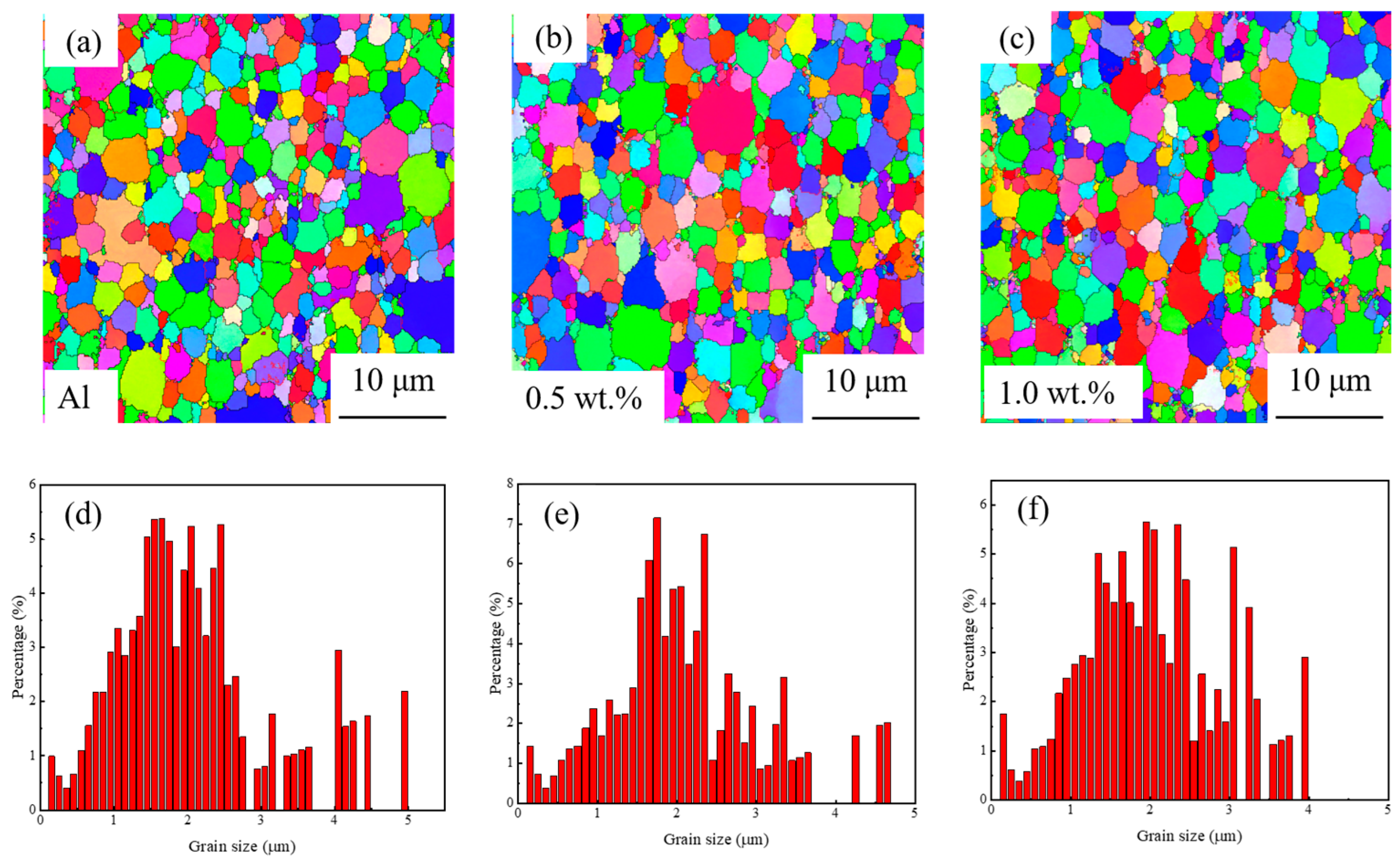
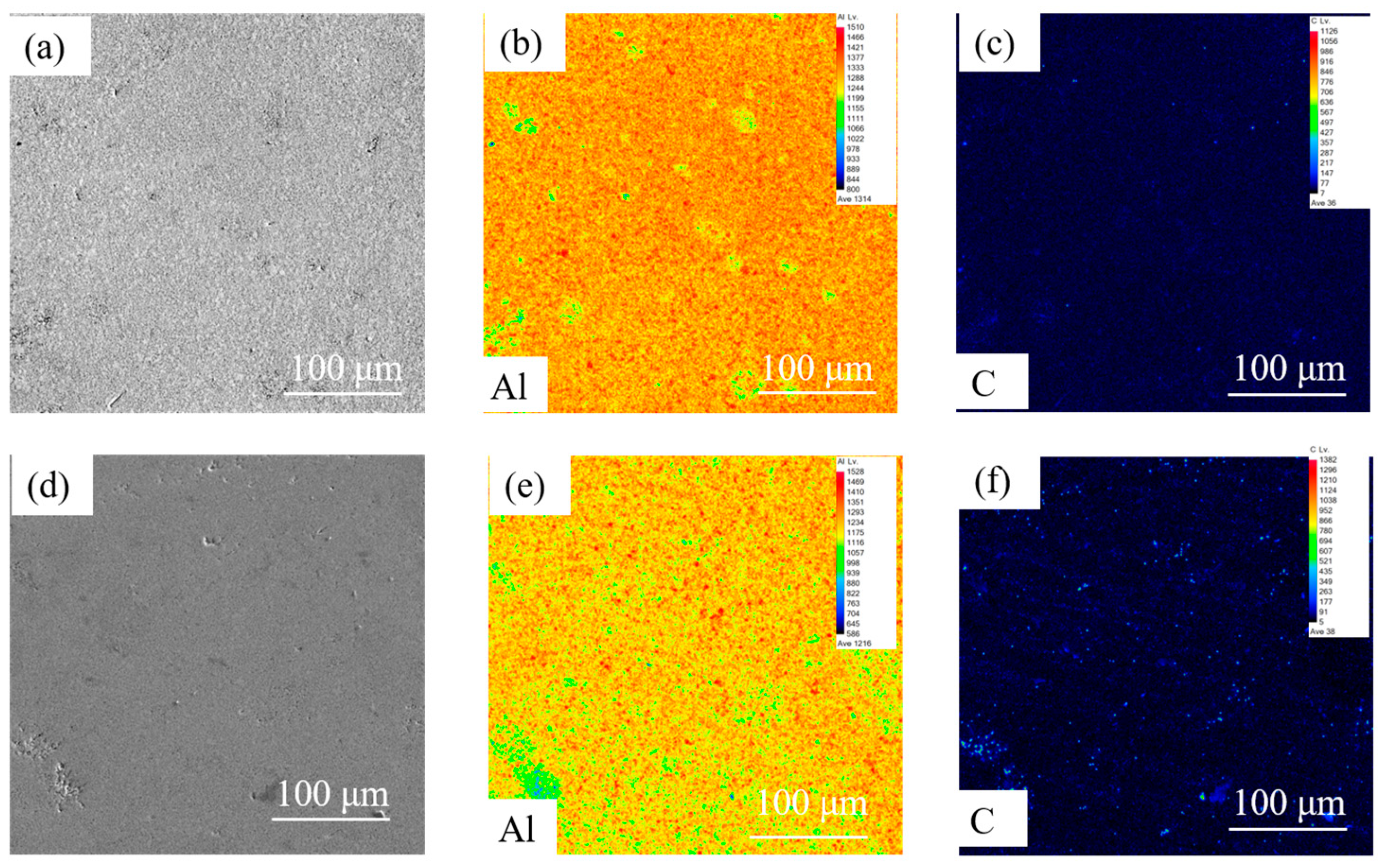

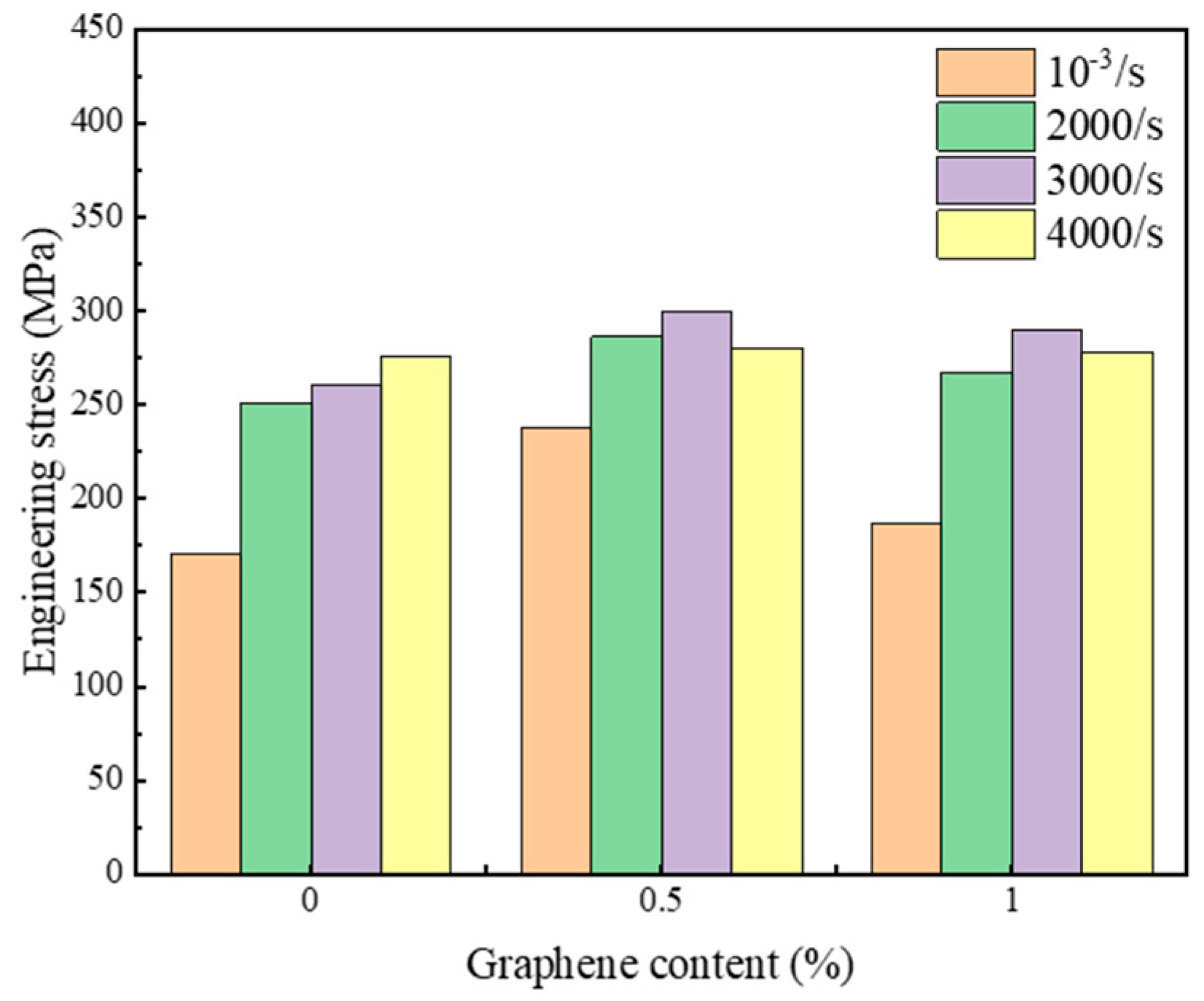
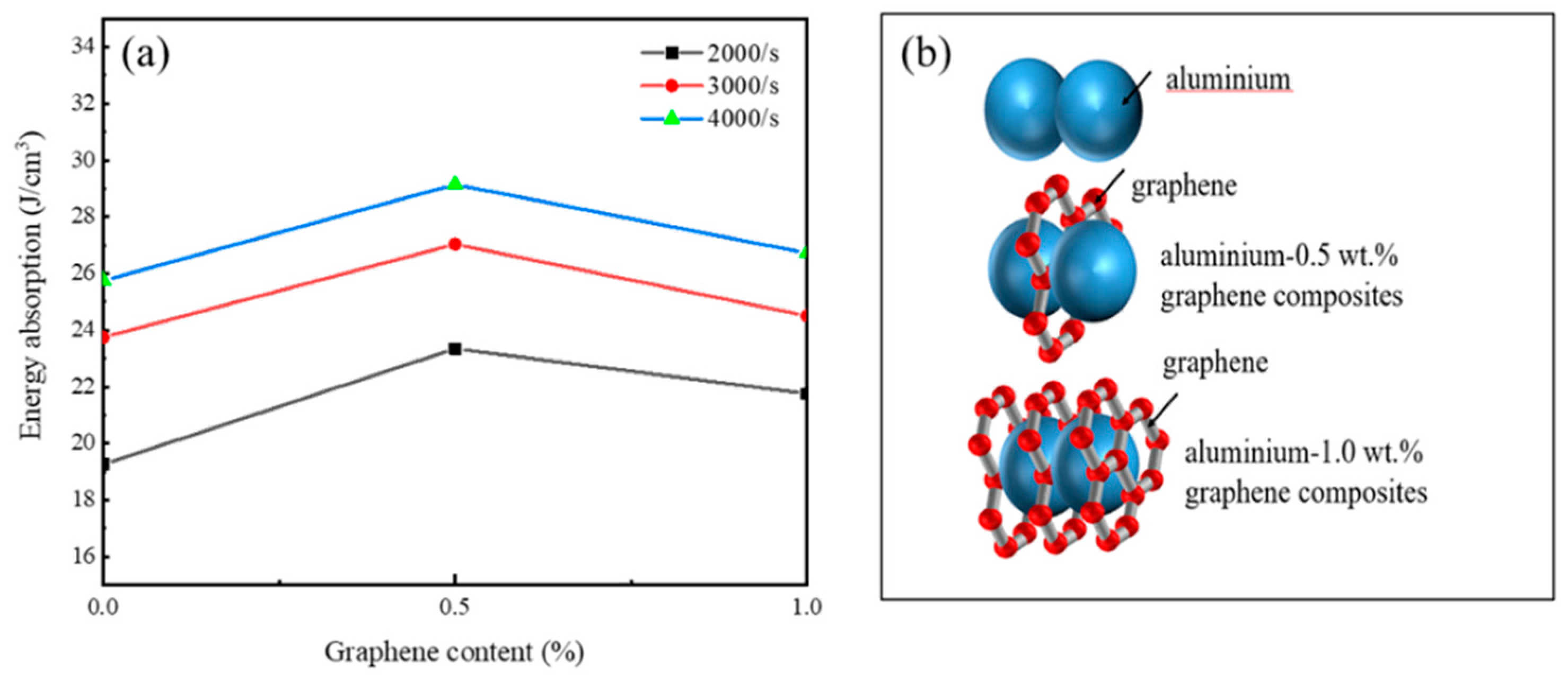

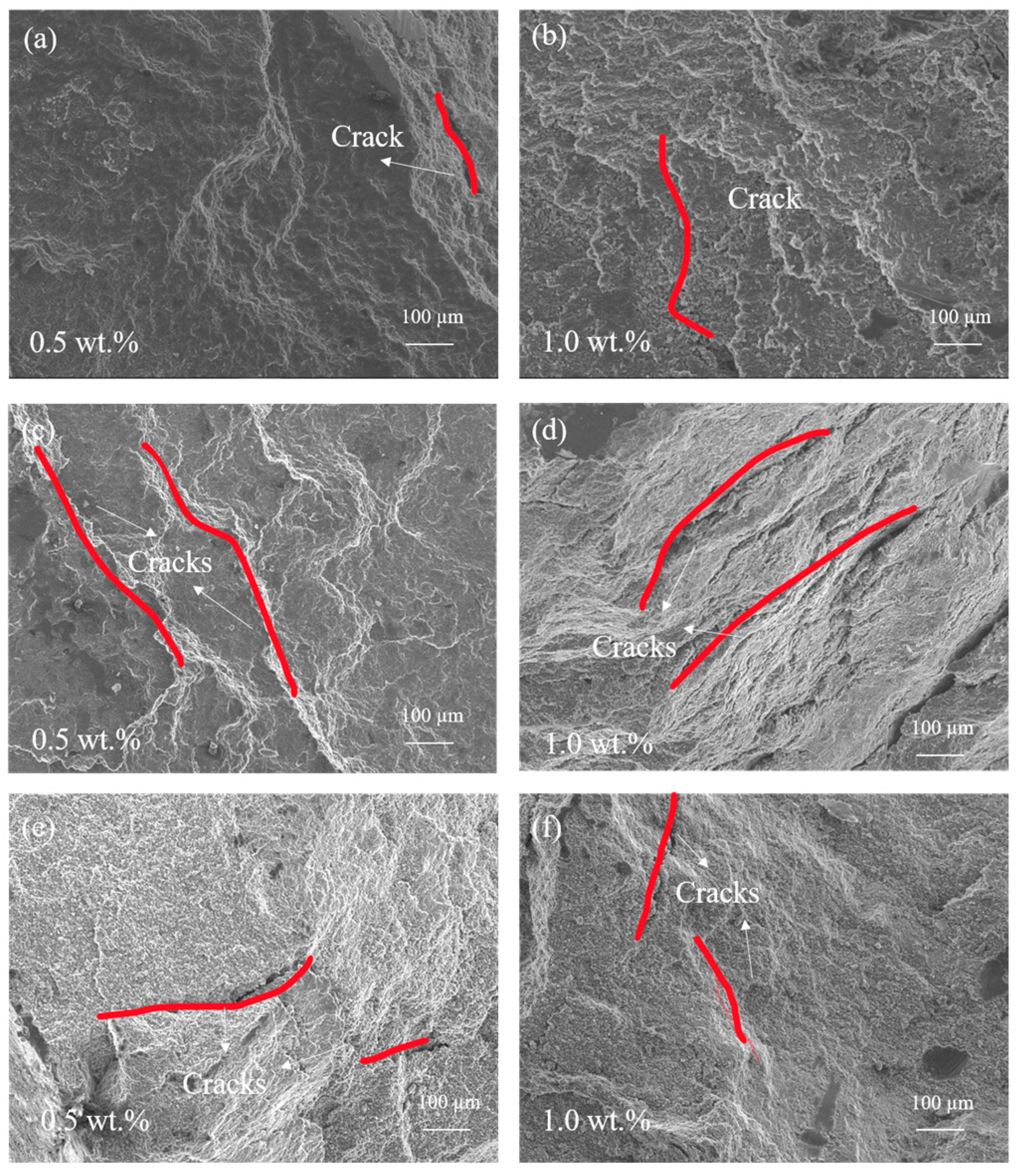
Disclaimer/Publisher’s Note: The statements, opinions and data contained in all publications are solely those of the individual author(s) and contributor(s) and not of MDPI and/or the editor(s). MDPI and/or the editor(s) disclaim responsibility for any injury to people or property resulting from any ideas, methods, instructions or products referred to in the content. |
© 2023 by the authors. Licensee MDPI, Basel, Switzerland. This article is an open access article distributed under the terms and conditions of the Creative Commons Attribution (CC BY) license (https://creativecommons.org/licenses/by/4.0/).
Share and Cite
Yan, Y.; Zhao, J.; Chen, L.; Zhao, H.; Klimova-Korsmik, O.; Tolochko, O.V.; Yin, F.; Ji, P.; Kang, S. Effect of Strain Rate on Compressive Properties of Aluminium-Graphene Composites. Metals 2023, 13, 618. https://doi.org/10.3390/met13030618
Yan Y, Zhao J, Chen L, Zhao H, Klimova-Korsmik O, Tolochko OV, Yin F, Ji P, Kang S. Effect of Strain Rate on Compressive Properties of Aluminium-Graphene Composites. Metals. 2023; 13(3):618. https://doi.org/10.3390/met13030618
Chicago/Turabian StyleYan, Yufu, Jiamin Zhao, Long Chen, Hongjian Zhao, Olga Klimova-Korsmik, Oleg V. Tolochko, Fuxing Yin, Puguang Ji, and Shaoming Kang. 2023. "Effect of Strain Rate on Compressive Properties of Aluminium-Graphene Composites" Metals 13, no. 3: 618. https://doi.org/10.3390/met13030618
APA StyleYan, Y., Zhao, J., Chen, L., Zhao, H., Klimova-Korsmik, O., Tolochko, O. V., Yin, F., Ji, P., & Kang, S. (2023). Effect of Strain Rate on Compressive Properties of Aluminium-Graphene Composites. Metals, 13(3), 618. https://doi.org/10.3390/met13030618








